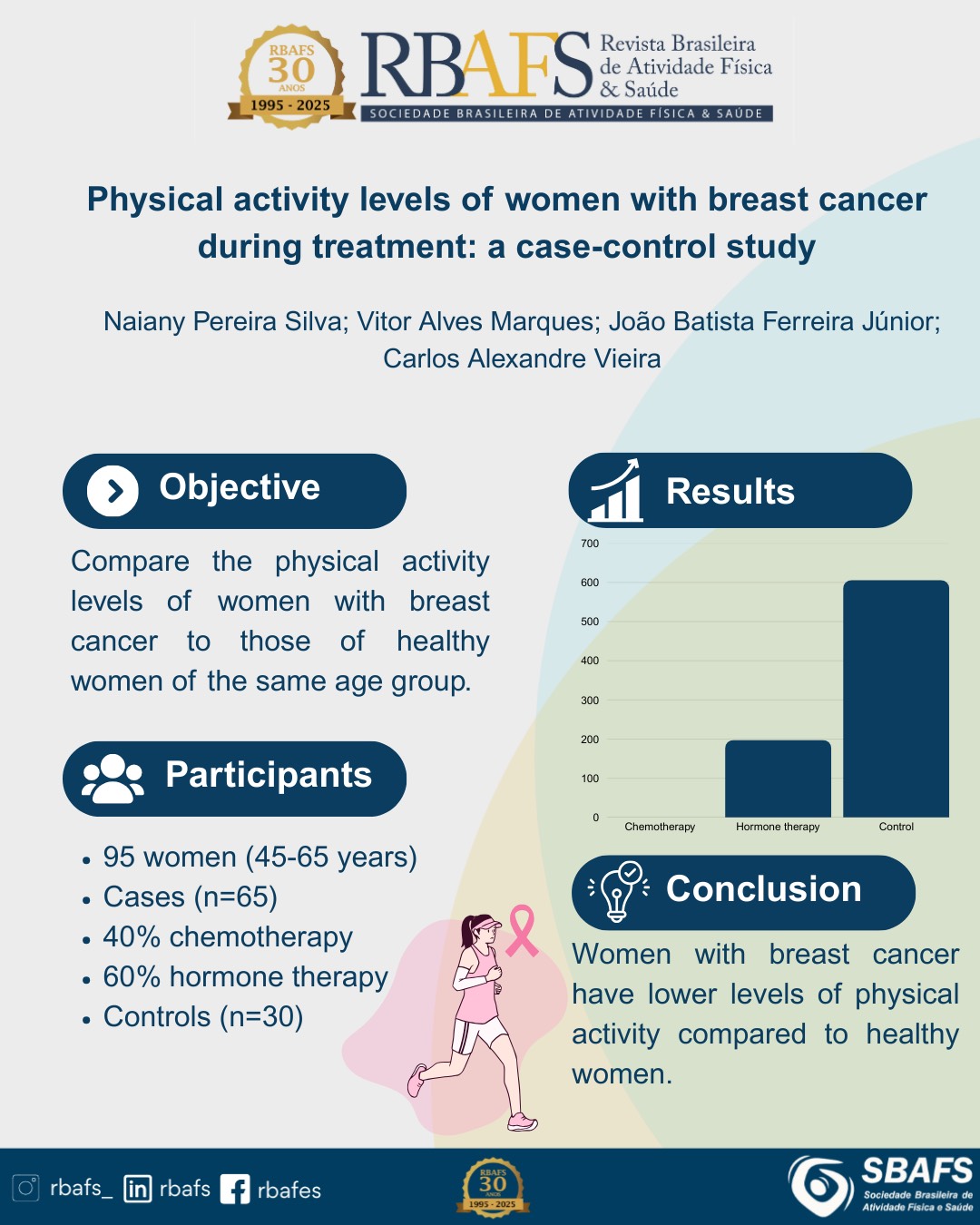Physical activity levels of women with breast cancer during treatment: a case-control study
DOI:
https://doi.org/10.12820/rbafs.30e0406Keywords:
Breast carcinoma, Physical activity, Chemotherapy, Hormone therapyAbstract
Introduction: Maintaining or increasing physical activity levels after a breast cancer diagnosis may contribute to reducing the risk of disease recurrence and improving survival among affected women. Objective: To compare the physical activity levels of women with breast cancer to those of healthy women of the same age group. Methods: A case control study was conducted between October 2021 and August 2022, including postmenopausal women aged 45 to 65 years. Women with breast cancer were recruited from the Goiânia Clinical Hospital, Goiás, Brazil. Approximately one age-matched control was selected from the general population for every 2.2 cases. Physical activity levels were assessed using the short version of the International Physical Activity Questionnaire. The final sample comprised 95 women, including 65 cases and 30 controls. Results: Among the cases, 40% (n = 26) were undergoing chemotherapy and 60% (n = 39) were receiving hormone therapy. Results: In the overall analysis, women with breast cancer presented significantly lower physical activity levels compared to the control group (median: 198 MET min/week; IQR: 0.00 – 547 vs. 606; IQR: 57.75 – 1062; p = 0.008). In the subgroup analysis, a statistically significant difference in physical activity levels was observed among the groups undergoing chemotherapy, hormone therapy, and the control group (p = 0.009). Conclusion: Women with breast cancer exhibit lower levels of physical activity compared to healthy women of the same age group. Randomized clinical trials and epidemiological studies are needed to establish causality.
Downloads
References
1. Friedreich CM, Neilson HK, Lynch BM. State of the epidemiological evidence on physical activity and cancer prevention. Eur J Cancer. 2010;46(14):2593-604. DOI: https://doi.org/10.1016/j.ejca.2010.07.028
2. McTiernan A. Mechanisms linking physical activity with cancer. Nat Rev Cancer. 2008;8(3):205-11. DOI: https://doi.org/10.1038/nrc2325
3. Monninkhof EM, Elias SG, Vlems FA, van der Tweel I, Schuit AJ, Voskuil DW, et al. Physical activity and breast cancer: a systematic review. Epidemiology. 2007;18(1):137–57. DOI: https://doi.org/10.1097/01.ede.0000251167.75581.98
4. Speck RM, Courneya KS, Mâsse LC, Duval S, Schmitz KH. An update of controlled physical activity trials in cancer survivors: a systematic review and meta-analysis. J Cancer Surviv. 2010;4(2):87-100. DOI: https://doi.org/10.1007/s11764-009-0110-5
5. Mishra SI, Scherer RW, Snyder C, Geigle P, Gotay C. The effectiveness of exercise interventions for improving health-related quality of life from diagnosis through active cancer treatment. Oncol Nurs Forum. 2015;42(1):E33-53. DOI: https://doi.org/10.1188/15.ONF.E33-E53
6. Mustian KM, Alfano CM, Heckler C, Kleckner AS, Kleckner IR, Leach CR, et al. Comparison of pharmaceutical, psychological, and exercise treatments for cancer-related fatigue: a meta-analysis. JAMA Oncol. 2017;3(7):961-8. d DOI: https://doi.org/10.1001/jamaoncol.2016.6914
7. Courneya KS, Friedenreich CM. Physical activity and cancer control. Semin Oncol Nurs. 2007 Nov;23(4):242-52. DOI: https://doi.org/10.1016/j.soncn.2007.08.002
8. Blaney JM, Lowe-Strong A, Rankin-Watt J, Campbell A, Gracey JH. The cancer rehabilitation journey: barriers to and facilitators of exercise among patients with cancer-related fatigue. Phys Ther. 2010;90(8):1135-47. DOI: https://doi.org/10.2522/ptj.20090278
9. Segal R, Zwaal C, Green E, Tomasone JR, Loblaw A, Petrella T. Exercise for people with cancer: a clinical practice guideline. Curr Oncol. 2017;24(1):40–6. DOI: https://doi.org/10.3747/co.24.3376
10. Knols R, Aaronson NK, Uebelhart D, Fransen J, Aufdemkampe G. Physical exercise in cancer patients during and after medical treatment: a systematic review of randomized and controlled clinical trials. J Clin Oncol. 2005;23(16):3830-42. DOI: https://doi.org/10.1200/JCO.2005.02.148
11. Schmidt ME, Wiskemann J, Steindorf K. Quality of life, problems, and needs of disease-free breast cancer survivors 5 years after diagnosis. Qual Life Res. 2018;27(8):2077-86. DOI: https://doi.org/10.1007/s11136-018-1866-8
12. Pinto BM, Trunzo JJ. Health behaviors during and after a cancer diagnosis. Cancer. 2005;104(S11):2614–23. DOI: https://doi.org/10.1002/cncr.21248
13. Matsudo S, Araújo T, Matsudo V, Andrade D, Andrade E, Oliveira L, Braggion G. International Physical Activity Questionnaire (IPAQ): validity and reproducibility study in Brazil. Rev. Bras. Ativ. Fís. Saúde. 2001;6(2):5-18.
14. Irwin ML, Crumley D, McTiernan A, Bernstein L, Baumgartner R, Gilliland FD, et al. Physical activity levels before and after a diagnosis of breast carcinoma: the Health, Eating, Activity, and Lifestyle (HEAL) study. Cancer. 2003;97(7):1746‐57. DOI: https://doi.org/10.1002/cncr.11227
15. Campbell KL, Winters-Stone KM, Wiskemann J, May AM, Schwartz AL, Courneya KS, et al. Exercise guidelines for cancer survivors: consensus statement from international multidisciplinary roundtable. Med Sci Sports Exerc. 2019;51(11):2375-90. DOI: https://doi.org/10.1249/MSS.0000000000002116
16. World Health Organization. WHO guidelines on physical activity and sedentary behaviour. Geneva: WHO; 2020. Available from: <https://www.who.int/publications/i/item/9789240015128> [2024 December].
17. Fong DYT, Ho JWC, Hui BPH, Lee AM, Macfarlane DJ, Leung SS, et al. Physical activity for cancer survivors: meta-analysis of randomised controlled trials. BMJ. 2012;344:e70. DOI: https://doi.org/10.1136/bmj.e70
18. Demark-Wahnefried W, Hars V, Conaway M, Havlin K, Rimer BK, McElveen G, et al. Reduced rates of metabolism and decreased physical activity in breast cancer patients receiving adjuvant chemotherapy. Am J Clin Nutr. 1997;65(5):1495-501. DOI: https://doi.org/10.1093/ajcn/65.5.1495

Downloads
Published
How to Cite
Issue
Section
License
Copyright (c) 2025 Naiany Pereira Silva, Vitor Alves Marques, João Batista Ferreira Junior, Carlos Alexandre Vieira

This work is licensed under a Creative Commons Attribution 4.0 International License.
When submitting a manuscript to the Revista Brasileira de Atividade Física & Saúde, the authors retain the copyright to the article and authorize the Revista Brasileira de Atividade Física & Saúde to publish the manuscript under the Creative Commons Attribution 4.0 License and identify it as the original publication source.


